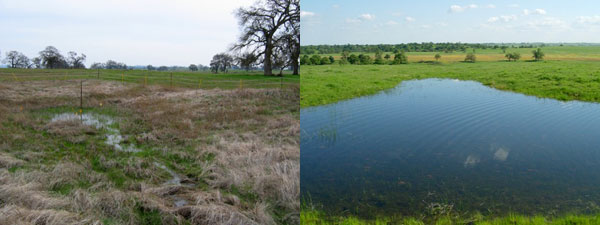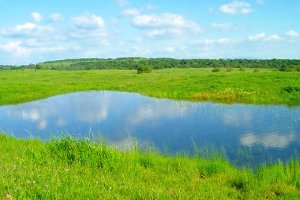[jwplayer config="QUEST Audio Player" skin="http://ww2.kqed.org/quest/wp-content/themes/quest/glow.zip" file="http://www.kqed.org/.stream/anon/radio/quest/2011/02/2011-02-14-quest.mp3"]
Listen to the QUEST radio story Land Preservation on the Chopping Block
Here's how it works: in exchange for agreeing not to develop their land, the Stones pay lower property taxes on their ranch. The program was created in 1965 to preserve open space in California. Today, it covers more than half of the state's farm and ranchland.
Under Governor Jerry Brown's proposed budget, state funding for the Williamson Act would be eliminated. "I think people have taken it for granted up until recently cause it's always been something that's out there," says Stone.
Stone says the program helps keep many ranchers afloat, given the volatile cattle market. "It's a very cyclical business. Eight years ago we were down in the dumps." Without the program, Stone expects his property taxes to jump 38 percent on the ranch. For his neighbors, he says, it could be higher and that creates pressure to subdivide the land. "In this type of area, everyone wants a ranchette in the country."
John Young, Yolo County Agricultural Commissioner, agrees. "The ranchers are gonna by far be hit the hardest here. The pressure on them is going to be to cut this acreage apart and start to sell it off chunk by chunk."
There may not be much development pressure today, but Young expects it to come back as the economy rebounds. And since ranchers need a lot of land to raise cattle, higher taxes will hit them hard. "Most farmers can't afford to pay those kind of taxes when it takes 40 acres for one cow/calf pair."
Counties will also be in a tight spot, if the legislature passes Brown's budget. Since counties collect lower property taxes under the program, the state usually reimburses them for the lost funds. In Yolo County, that's supposed to be 1.3 million dollars a year.
Of course, these days, all of California is facing some tough cuts, as Governor Brown said a few weeks ago. "Do I like the choices we face? No, I don't like them. But after serious study of the options left by a 25 billion dollar deficit, the budget I proposed is the best that I can devise," he said in the State of the State address.
John Young says it would fall to the counties to decide if they can continue the conservation program without state support. "Williamson Act is one of the best land conservation acts that's ever existed anywhere. So really this is a statewide issue. It shouldn't be on each individual county to decide that."
But the Williamson Act isn't just something that ranchers care about. On Howard Ranch, a 12,000-acre cattle ranch in eastern Sacramento County, Jaymee Marty is standing next to what looks like a small pond. Marty is an ecologist with the Nature Conservancy.
"A vernal pool is basically a season wetland and this is sort of a little hotspot of native diversity," she says.
These small wetlands may not seem like much, but every spring, they only appear in California's grasslands. By summer, they're completely dried up. "So you have you know hundreds of plant species that are found nowhere else in the world except in California in vernal pools." They're also home to species like ferry shrimp and tiger salamanders.
 Two different vernal pools in Jaymee Marty's research. On the left is a pool that's been fenced off from cattle, while the pool on the right was left open. The fenced pool is choked with thatch and invasive weeds like Medusahead. Cattle have kept those plants down in the open pool, which Marty says is a more productive environment for tiger salamanders and other species that depend on these seasonal pools. Photos: Jaymee Marty and Jennifer Buck.
Two different vernal pools in Jaymee Marty's research. On the left is a pool that's been fenced off from cattle, while the pool on the right was left open. The fenced pool is choked with thatch and invasive weeds like Medusahead. Cattle have kept those plants down in the open pool, which Marty says is a more productive environment for tiger salamanders and other species that depend on these seasonal pools. Photos: Jaymee Marty and Jennifer Buck.
Ten years ago, Marty began a study to see if cattle were harming these tiny communities. "I thought that I was going to find that some species were really going to lose out in a grazed grassland."
Instead, Marty found that cattle help create a better environment for vernal pools. There are types of grazing that are not good for the ecosystem, says Marty, but studies have shown that rangeland is an important habitat for raptors and other wildlife.
That's why the loss of more than 500,000 acres of California ranchland over the last quarter century is a concern. "It's pretty shocking. Some counties have a lot more loss than others."
And that, says Marty, is where the Williamson Act comes in. "Really the only reason that this grassland is in existence today is because it has been ranched, because people have been able to make a living off of it."
That's why she sees the Williamson Act as an important conservation tool in California. But in Sacramento, the act is competing with schools and health care for limited funding. Legislators are now holding budget hearings that will decide the future of the program.
38.623317 -122.02352
 Under Governor Jerry Brown's proposed budget, state funding for the Williamson Act would be eliminated. Photo Credit: Jennifer Rusk
Under Governor Jerry Brown's proposed budget, state funding for the Williamson Act would be eliminated. Photo Credit: Jennifer Rusk
 Two different vernal pools in Jaymee Marty's research. On the left is a pool that's been fenced off from cattle, while the pool on the right was left open. The fenced pool is choked with thatch and invasive weeds like Medusahead. Cattle have kept those plants down in the open pool, which Marty says is a more productive environment for tiger salamanders and other species that depend on these seasonal pools. Photos: Jaymee Marty and Jennifer Buck.
Two different vernal pools in Jaymee Marty's research. On the left is a pool that's been fenced off from cattle, while the pool on the right was left open. The fenced pool is choked with thatch and invasive weeds like Medusahead. Cattle have kept those plants down in the open pool, which Marty says is a more productive environment for tiger salamanders and other species that depend on these seasonal pools. Photos: Jaymee Marty and Jennifer Buck.